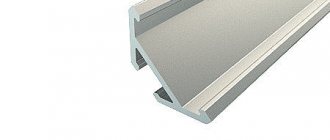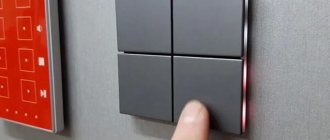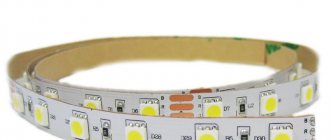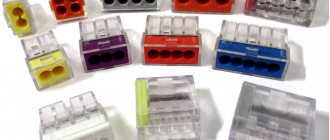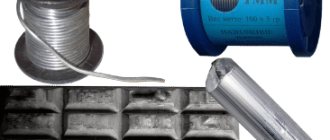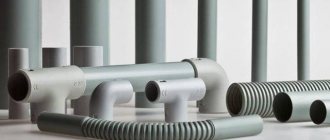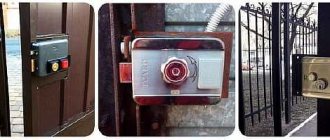Lead-tin solders are widely used in radio electronics for soldering various microcircuits. Achieving high-quality results with their use becomes possible only when the master is well versed in the soldering process and understands the basic rules of operation and selection of solders.
Beginning radio amateurs often ask themselves: which solder is best to choose in this particular case, and what properties they have. This article will help you solve the problem.
Lead-tin solders
Lead-tin solders are divided into soft and hard. The former are fusible and are widely used in working with radio equipment. Their melting point is in the range of 300–450 degrees.
Compositions of lead-tin solders.
This type of alloy is characterized by lower hardness compared to refractory options, however, they are the ones most often used in the installation of microcircuits.
The composition of soft options is a combination of two elements: lead and tin. Alloying elements can also be added. The content of such impurities is insignificant. They are introduced to give the compound certain properties, such as ductility, strength, and so on.
Why are they made from tin? The fact is that stanum is the best material for soldering. It has a number of advantages. These include high conductivity and excellent wetting. However, there are also disadvantages, for example, it is susceptible to the phenomenon of tin plague, the formation of intermetallic surfaces, etc.
You can avoid such problems by adding plumbum, copper, silver, and gold. If the first element is absent in the composition, then the alloy is called lead-free. It is safer for the master. In practice, solders containing lead and designated by the letters “POS” are most often used.
Low temperature solders
Low-melting solders have a transition temperature to the liquid state of up to 450 °C. They are used in radio engineering connections, when soldering wires, and other works. The main components of such soldering products are alloys of tin, lead, cadmium or bismuth. In the process of degreasing and tinning technical boards, Wood or Rose alloys are used. Such substances become liquid already at around 70 °C.
Low temperature solder
Metals have different melting points, it is important to familiarize yourself with the composition of the solder before purchasing.
- Tin is a low-melting metal that is dissolved by sulfuric or hydrochloric acid. The metal melts at 232 °C; exposure to standard room temperatures does not affect it, but at -50 °C the composite crystal lattice is destroyed.
- Lead is popular due to its fusibility and easy processing. Only the surface exposed to ambient air is oxidized.
- Cadmium is used for anti-corrosion purposes when soldering tin and lead products. The material itself is toxic, melting at 321 °C.
- Bismuth is added to the composition due to its solubility in sulfuric acid and nitrogen media.
The most convenient form of release for soldering radio components is wire with a diameter of 2-2.5 cm. The composition of modern products is rosin, which acts as a flux.
Compound
As noted above, lead solder usually contains Sn and Pb. The percentage amount of the first element is indicated by the numbers behind the letters. For example, POS-40 contains forty percent of stanum, and POS-60 contains sixty. It is worth noting that POS-60 and 61 have the same composition, but are labeled differently.
Many people often do not pay due attention to the composition of the alloy when soldering. Nevertheless, this point is very important, because it determines the installation characteristics and the quality of the work performed.
Brands of soft solders for soldering with a soldering iron
Soft solders are used in conjunction with an electric soldering iron and flux. The tin included in the composition is an environmentally friendly product and can be used to connect elements of the food industry. The most common soldering product is the tertiary, which got its name due to the composition containing a third of lead . Soft solders are divided into varieties according to their purpose and melting temperature.
Solder POSV-33
Low-melting solders are used for soldering heat-sensitive parts such as fuses and transistors. The composition includes lead, tin, bismuth and cadmium, the latter material is toxic and is not used in all areas of activity. Melting of Wood's products begins at the lowest temperature - 69 °C.
Domestic brands of products are labeled POS; with the addition of some substances, the name changes. For example, POSV - 33 has equal parts of lead, tin and copper, and is applied to brass and copper parts that require a sealed seam.
Main technical characteristics of soft solders for soldering with an electric soldering iron
The technical characteristics of materials used for soldering are divided into several parameters:
- conductivity or electrical resistivity is 0.1 ohm per meter. Tin-lead type solder conducts electric current an order of magnitude worse than aluminum or copper;
- Tensile strength is measured kg/mm; low-temperature solders do not include this parameter, because not designed for load. The parameter depends on the amount of tin; the more there is, the higher the number. For example, POS-61 brand solder has a strength of 4.3 kg per mm, and POS-90 solder has a strength of 4.9 kg/mm.
- The melting point depends on the purpose and components.
Purpose
Depending on the content of a particular material, alloys have different areas of application.
Table of types of solders.
POS-90 is used in the repair of food utensils and medical supplies. It contains a small amount of plumbum, a material toxic to humans.
POS-40 is most often used when working with electrical devices and parts made of galvanized iron. Also serves as a basis for repairing brass and copper pipelines. This connection can replace POS 18 solder, used for the same purposes.
Alloys with 30% stanum content are excellent for the cable industry, tinning and zinc soldering.
Soldering of radio equipment boards is most often carried out using POS-61. It is this option that serves as the main one in the installation of radio electronics parts. You can solder microcircuits with this alloy using a simple soldering iron.
1.BRANDS
1.1 Depending on the chemical composition, tin-lead solders are manufactured in the following grades:
antimony-free – POS 90, POS 63, POS 61, POS 40, POS 30, POS 10, POS 61M, POSK 50-18, POSK 2-18;
low antimony - POSSU 61-0.5, POSSU 50-0.5, POSSU 40-0.5, POSSU 30-2, POSSU 25-2, POSSU 18-2, POSSU 15-2, POSSU 10-2, POSSU 8 -3, POSSU 5-1, POSSU 4-6, POSSU 4-4.
Examples of symbols:
Solder in ingots brand POS 40:
Solder Ch POS 40 GOST 21930-76
The same, brand POSSu 18-0.5:
Solder Ch POSSu 18-0.5 GOST 21930-76
| Mass fraction, % | ||||||
| Solder grade | OKP code | Main components | ||||
| Tin | Antimony | Cadmium | Copper | Lead | ||
| Antimony-free | ||||||
| POS 90 | 17 2311 1100 04 | 89-91 | — | — | — | Rest |
| POS 63 | 17 2312 0100 | 62,5-63,5 | — | — | — | |
| POS 61 | 17 2312 1100 10 | 59-61 | — | — | — | Same |
| POS 40 | 17 2314 1100 00 | 39-41 | — | — | — | “ |
| POS 30 | 17 2321 1100 09 | 29-31 | — | — | — | “ |
| POS 10 | 17 2326 1100 06 | 9-10 | — | — | — | “ |
| POS 61M | 17 2312 1200 07 | 59-61 | — | — | 1,2-2,0 | “ |
| POSK 50-18 | 17 2313 1200 02 | 49-51 | — | 17-19 | — | “ |
| POSK 2-18 | 17 2343 1100 09 | 1,8-2,3 | — | 17,5-18,5 | — | “ |
| Low antimony | ||||||
| POSSu 61-0.5 | 17 2312 1400 01 | 59-61 | 0,05-0,5 | — | — | Rest |
| POSSu 50-0.5 | 17 2313 1100 05 | 49-51 | — | — | Same | |
| POSSu 40-0.5 | 17 2314 1200 08 | 39-41 | — | — | “ | |
| POSSu 35-0.5 | 17 2315 1200 03 | 34-36 | — | — | “ | |
| POSSU 30-0.5 | 17 2321 1200 06 | 29-31 | — | — | “ | |
| POSSu 25-0.5 | 17 2322 1200 01 | 24-26 | — | — | “ | |
| POSSu 18-0.5 | 17 2323 1100 10 | 17-18 | — | — | “ | |
| Antimony | ||||||
| POS 95-5 | 17 2311 1200 01 | Rest | 4,0-5,0 | — | — | — |
| POSSu 40-2 | 17 2314 1300 05 | 39-41 | 1,5-2,0 | — | — | Rest |
| POSSu 35-2 | 17 2315 1300 00 | 34-36 | 1,5-2,0 | — | — | Same |
| POSSu 30-2 | 17 2321 1300 03 | 29-31 | 1,5-2,0 | — | — | “ |
| POSSu 25-2 | 17 2322 1300 09 | 24-26 | 1,5-2,0 | — | — | “ |
| POSSu 18-2 | 17 2323 1200 07 | 17-18 | 1,5-2,0 | — | — | “ |
| POSSu 15-2 | 17 2324 1100 05 | 14-15 | 1,5-2,0 | — | — | “ |
| POSSu 10-2 | 17 2326 1200 03 | 9-10 | 1,5-2,0 | — | — | “ |
| POSSu 8-3 | 17 2326 1300 00 | 7-8 | 2,0-3,0 | — | — | “ |
| POSSu 5-1 | 17 2327 1100 0 | 4-5 | 0,5-1,0 | — | — | “ |
| POSSU 4-6 | 17 2327 1200 09 | 3-4 | 5,0-6,0 | — | — | “ |
| POSSU 4-4 | 17 2327 1300 06 | 3-4 | 3,0-4,0 | — | — | “ |
| Impurities, nothing more. % | |||||||||||||||
| Solder grade | |||||||||||||||
| Antimony | Copper | Bismuth | Arsenic | Iron | Nickel | Sulfur | Zinc | Aluminum | Lead | ||||||
| Antimony-free | |||||||||||||||
| POS 90 | 0,10 | 0,05 | 0,1 | 0,01 | 0,02 | 0,02 | 0,02 | 0,002 | 0,002 | — | |||||
| POS 63 | 0,05 | 0,05 | 0,02 | ||||||||||||
| POS 61 | 0,10 | 0,05 | 0,20 | 0,02 | |||||||||||
| POS 40 | 0,10 | 0,05 | 0,02 | ||||||||||||
| POS 30 | 0,10 | 0,05 | 0,02 | ||||||||||||
| POS 10 | 0,10 | 0,05 | 0,02 | ||||||||||||
| POS 61M | 0,20 | — | 0,01 | ||||||||||||
| POSK 50-18 | 0,20 | 0,08 | 0,03 | ||||||||||||
| POSK 2-18 | 0,05 | 0,05 | 0,01 | ||||||||||||
| Low antimony | |||||||||||||||
| POSSu 61-0.5 | — | 0,05 | 0,20 | 0,02 | 0,02 | 0,02 | 0,02 | 0,02 | 0,02 | — | |||||
| POSSu 50-0.5 | 0,05 | 0,10 | 0,02 | ||||||||||||
| POSSu 40-0.5 | 0,05 | 0,20 | 0,02 | ||||||||||||
| POSSu 35-0.5 | 0,05 | 0,02 | |||||||||||||
| POSSU 30-0.5 | 0,05 | 0,02 | |||||||||||||
| POSSu 25-0.5 | 0,05 | 0,02 | |||||||||||||
| POSSu 18-0.5 | 0,05 | 0,02 | |||||||||||||
| Antimony | |||||||||||||||
| POS 95-5 | — | 0,05 | 0,1 | 0,04 | 0,02 | 0,02 | 0,02 | 0,002 | 0,002 | 0,07 | |||||
| POSSu 40-2 | 0,08 | 0,2 | 0,02 | 0,08 | — | ||||||||||
| POSSu 35-2 | 0,08 | 0,02 | |||||||||||||
| POSSu 30-2 | 0,08 | 0,02 | |||||||||||||
| POSSu 25-2 | 0,08 | 0,02 | |||||||||||||
| POSSu 18-2 | 0,08 | 0,02 | |||||||||||||
| POSSu 15-2 | 0,08 | 0,02 | |||||||||||||
| POSSu 10-2 | 0,08 | 0,02 | |||||||||||||
| POSSu 8-3 | 0,1 | 0,05 | |||||||||||||
| POSSu 5-1 | 0,08 | 0,02 | |||||||||||||
| POSSU 4-6 | 0,1 | 0,05 | |||||||||||||
| POSSU 4-4 | 0,1 | 0,05 | |||||||||||||
Properties
As noted earlier, there is a division of solders into two categories depending on the melting point. Soft or fusible are alloys that melt at less than 450 °C. It is worth noting that they are not necessarily made of tin. Gallium, bismuth, cadmium, and indium can be used here.
However, often not one, but a mixture of several elements is used. This is necessary to give the alloy the necessary characteristics and parameters. The most common are POS.
It is important to know: it is possible to distinguish one brand of alloy from another without knowing its exact composition, due to the fact that the color of the wire, shine, ductility, hardness, etc. can change depending on the content of certain elements.
Solder chart for aluminum soldering.
Thus, by picking up a wire, trying to bend it and estimating its weight, you can determine with certain accuracy the content of stanum or plumbum in it.
Depending on the concentration of tin, several dozen alloys are distinguished, produced in accordance with the state standard - GOST.
When it comes to properties, they are mainly determined by the tin content. It has two polymorphic modifications. White – with a tetragonal crystal lattice, gray – with a cubic lattice. The transition from one modification to another is accompanied by the release of heat, that is, the reaction is exothermic.
This transformation also leads to an increase in volume, accompanied by destruction with the formation of gray powder. This process is called “tin plague”.
The speed of transformation of the white modification into gray is low. This process limits the use of pure stanum in soldering. In this regard, various chemical elements are added to prevent this transition.
It is also known that such characteristics of tin as strength and hardness are increased by adding nickel, copper, magnesium, and zinc. But the presence of bismuth and zinc will increase wettability and lower the melting point.
POSs cannot be strengthened by cold hardening. Unlike pure stanum, alloys with lead after deformation have less hardness and strength than cast ones.
As a result, by combining different impurity concentration options, it is possible to achieve the desired alloy parameters that are best suited for each specific task.
Types of solders
Solder is not always necessary to purchase. You can use an old radio component and assemble it from the board tracks using a soldering iron tip. This option is perfect for those who live far from the city, where it is not possible to purchase the material in a store.
Standard lead solders.
However, they are different and differ in their properties and characteristics. In this regard, every experienced master should understand this issue. To solder parts, it is necessary to use special alloys - solders.
The latter have a lower melting point than individual parts of the products.
Such alloys are divided into two main categories depending on their melting point: soft and hard. The first type is widely used in radio electronics, both by amateurs and professionals.
Low-melting solders include solders with a melting point of less than 450°C. They are made from: gallium, indium, tin, bismuth, lead and cadmium. High-temperature ones melt when heated above 450°C. In any case, it is usually an alloy consisting of several metals and impurities.
The most common option is a tin-lead alloy called PIC. The numbers after the abbreviation indicate the percentage of tin.
You can distinguish one alloy from another without knowing the brand. For example, with a higher tin content, a characteristic metallic luster appears, and with a higher lead concentration, the color becomes dark gray.
In addition, the melting point of POS does not exceed 265°C. Another distinctive feature of alloys with a higher proportion of lead is their ductility and the ability to be easily bent by hand.
Classification of alloys is carried out in accordance with GOST standards.
Physico-mechanical properties of solders.
The most common are:
- solder POS 90;
- POS 61;
- POS 40;
- POS 30.
In fact, there are significantly more markings. There are several dozen of them. Each is written in such a way that the composition of the alloy becomes clear from its name; all are manufactured in accordance with GOST 21930-76 tin-lead solder.
It is worth noting that the alloys differ from each other not only in their chemical composition. Depending on the form of release, they come in ingots, wire, a tube with rosin, or in a rod.
For example, POS 61 solder can be sold in rods or in the form of wire of various diameters. It is important to understand that the ratio of lead to tin affects the melting point. This parameter largely determines the choice of the required alloy.
In addition, the alloy can be produced with a flux, for example, with FRK525-2-T1, a low-activity halogen-free rosin flux.
This flux contains no halogens. Thanks to this fact, it has significantly less harm to the health of masters.
The use of alloys of various grades is determined by the scope of their application. POS thirty and forty are considered soft. Their melting point does not exceed 300°C. Used in joining galvanized products, tinning, repairing electrical appliances, etc.

